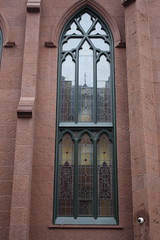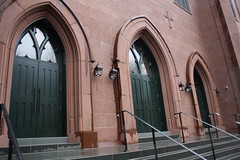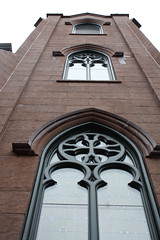St. Brigid’s Roman Catholic Church, at Avenue B and East Eighth Street, has pushed back its reopening yet again.
“The process has simply taken longer than we originally thought,” said Joseph Zwilling, a spokesperson for the church’s owner, the Archdiocese of New York.
The church’s main building, built in the 1840s by Irish immigrants fleeing the potato famine, closed in 2001, after a back wall that had been slowly pulling away from the main structure for two decades began to accelerate its separation. The building was slated for demolition until an anonymous benefactor donated $20 million in 2008.
Today, the initial cause of the closure continues to be a challenge. “The damage on the back wall has taken longer to resolve,” said Mr. Zwilling. “It has been a complex issue to repair in order to make sure it is not a running problem in 20 years again.”
Last year, when The Local documented the church’s painstaking restoration, it was expected to reopen in time for its patron saint’s feast week, in February of this year. But in February, The Villager took another look at the restoration and predicted the church wouldn’t reopen until Thanksgiving. Now the Department of Buildings estimates that it will be ready “early in the new year,” Mr. Zwilling said.
When it does reopen, the parish will merge with St. Emeric’s, on East 13th Street, near Avenue C. “The new parish will be called St. Brigid’s, St. Emeric’s Church,” said Mr. Zwilling.
Reverend Lorenzo Ato, the pastor at St. Emeric’s, is currently living at St. Brigid’s rectory and will be pastor of the new parish. As of now, the Archdiocese doesn’t know what will become of the St. Emeric’s building.
“We haven’t made a final determination on that,” said Mr. Zwilling. “I know they are looking to see if it can be used by other Catholic agencies, if there is a need. There is a potential that it would go on the market.”
Mr. Zwilling said the parish merger is part of a planning initiative dubbed “Making All Things New.” The “strategic parish planning,” launched in 2011, is meant to revitalize parishes by consolidating the abundance of Manhattan churches that are in close proximity to each other.
The initiative has led to sales and closures such as that of Mary Help of Christians. Parishioners of that church were relocated to Immaculate Conception Church in September, but some said they planned to attend mass at St. Brigid’s instead.
“We’ve seen this before when we merged Our Lady of Guadalupe and St. Bernard’s over on 14th Street,” said Mr. Zwilling. “The new community blended together very well.”
The Archdiocese hopes the same will occur when the new St. Brigid’s, St. Emeric’s Church finally has a chance to open its doors.








